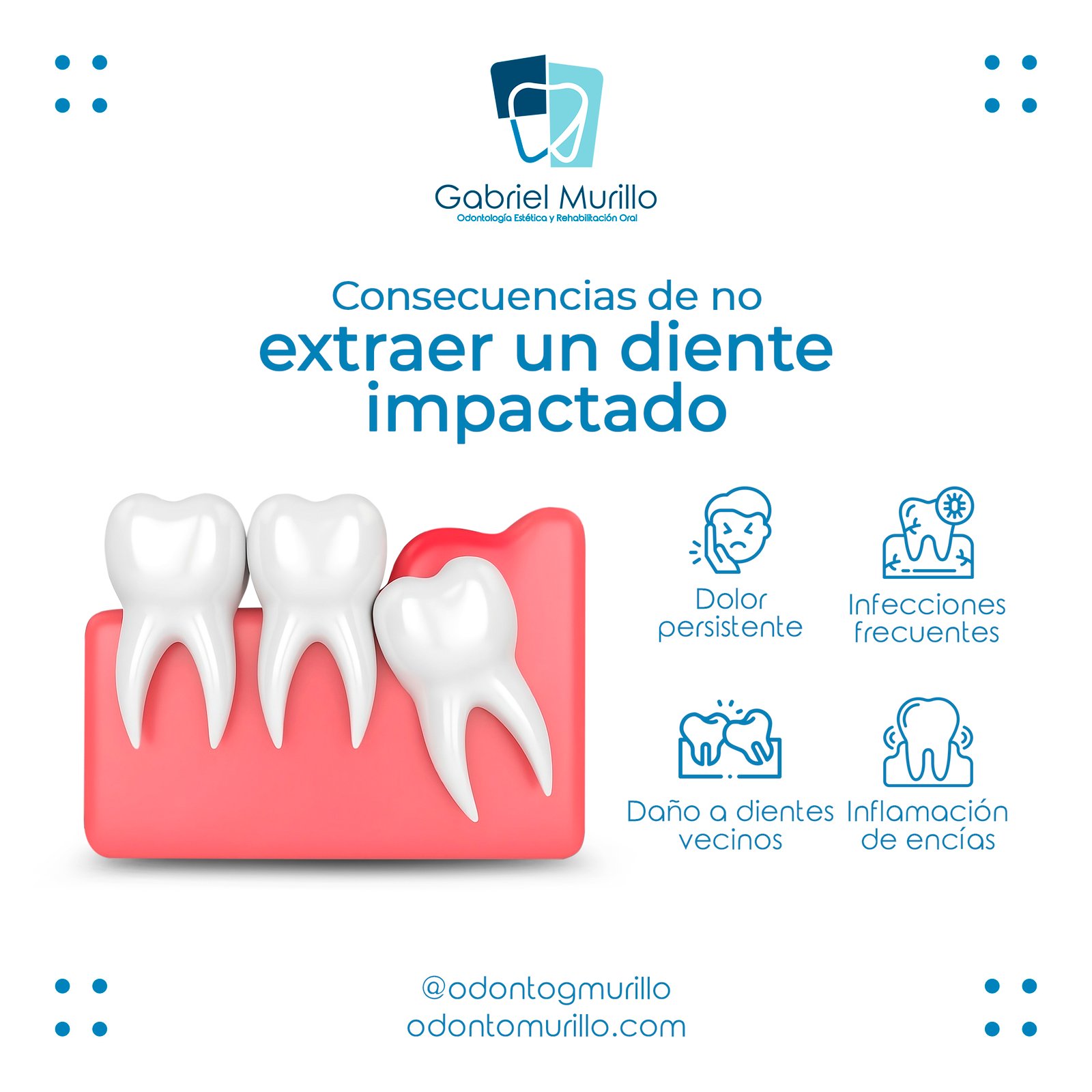Wisdom teeth, also known as third molars, are the last molars to appear in the mouth, usually between the ages of 17 and 25. In many cases, these teeth do not have enough space to erupt properly, which causes them to remain trapped or impacted in the gums or bone. This situation can lead to pain, swelling, infections, and damage to neighboring teeth.
Impacted tooth extraction is an oral and maxillofacial surgical procedure aimed at preventing and treating these complications, improving oral health, and avoiding future problems. At Odontomurillo, a dental clinic in Colombia, led by Dr. Gabriel Murillo, we perform this procedure under high safety standards, including panoramic X-rays that allow us to plan the surgery with precision.
What Are Impacted Teeth and Why Do They Occur?
Impacted teeth are those that fail to fully emerge through the gums, either because there is not enough space, they are poorly positioned, or they encounter an obstacle along the way. This issue occurs most frequently with wisdom teeth since they are the last to erupt, and in many patients, the dental arch does not have enough space to accommodate them.
When a tooth remains trapped, it can be partially covered by the gums or completely inside the bone. In either case, there is a risk of complications such as recurrent infections, constant pain, or displacement of neighboring teeth. For this reason, early extraction of impacted wisdom teeth is a common dental recommendation.
At Odontomurillo, the initial diagnosis includes a panoramic X-ray, which allows us to visualize the exact position of the wisdom teeth and their relationship with nerves, bone, and other teeth. Thanks to this tool, the surgical plan is customized for each patient, ensuring greater safety during the procedure.
Symptoms and Problems Caused by Impacted Wisdom Teeth
Impacted wisdom teeth may go unnoticed in their early stages, but over time they can cause symptoms that affect the patient’s quality of life. One of the most common signs is intermittent pain in the back of the mouth, which worsens when chewing or making jaw movements.
Another frequent issue is gum inflammation around the impacted tooth, leading to bleeding, discomfort while brushing, and sometimes bad breath. This inflammation can result in pericoronitis, a painful infection caused by bacteria accumulating in the tissue that partially covers the impacted tooth.
Additionally, impacted wisdom teeth can push against adjacent teeth, causing crowding, cavities in neighboring molars, or even bone damage. In severe cases, they may lead to cysts that compromise jawbone health. For all these reasons, proper evaluation and timely treatment are essential to prevent serious complications.
The Step-by-Step Extraction Procedure
Impacted tooth extraction is a planned surgical procedure that follows a rigorous protocol to ensure a successful outcome. At our clinic, the process involves the following steps:
Clinical Evaluation and Panoramic X-Ray
The first stage involves a thorough diagnosis, including a clinical exam and a panoramic X-ray. This image helps determine the tooth’s position, level of impaction, relation to nerves, and the case’s complexity. With this information, we select the safest and most effective surgical technique.
Anesthesia and Patient Preparation
The procedure is performed under local anesthesia, although in complex cases, sedation may be used. This ensures that the patient feels no pain during surgery. Beforehand, safety measures are taken, and the surgical area is carefully prepared to minimize infection risks.
Surgical Tooth Extraction
The surgeon makes a small incision in the gum and, in some cases, removes a small portion of bone to access the impacted tooth. If necessary, the tooth is sectioned into fragments to facilitate its removal. Once extracted, the area is cleaned and sutured with absorbable stitches. The procedure typically lasts between 30 and 60 minutes, depending on complexity.

Postoperative Care and Recovery
Recovery after impacted wisdom tooth extraction is usually quick if the specialist’s recommendations are followed. In the first few days, it is normal to experience swelling, mild bleeding, and discomfort when opening the mouth or chewing. These symptoms typically disappear within one to two weeks.
Key postoperative care tips include:
- Apply cold compresses to the area during the first 48 hours.
- Avoid vigorous rinsing or spitting on the first day.
- Stick to a soft diet and avoid very hot or spicy foods.
- Do not smoke or consume alcohol during healing.
- Take prescribed medications to control pain and prevent infections.
At Odontomurillo, we accompany patients throughout the entire recovery process with regular follow-ups to ensure proper healing and prevent complications.
Benefits of Impacted Wisdom Tooth Extraction
Choosing to remove impacted wisdom teeth offers multiple benefits that improve both oral health and overall quality of life. First, it eliminates recurring pain and swelling associated with impacted molars.
Another important benefit is the prevention of infections, cavities, and gum disease, since impacted wisdom teeth are difficult to clean and tend to accumulate bacteria. Removing them significantly reduces these risks.
Lastly, extraction helps maintain proper dental alignment, preventing crowding or shifting of adjacent teeth. This is especially beneficial for patients who have undergone orthodontic treatment, as it helps preserve long-term results.
Possible Risks and How We Minimize Them
Like any surgical procedure, impacted wisdom tooth extraction involves certain risks, although they are rare when performed under safe conditions. Potential complications include postoperative infection, excessive bleeding, damage to neighboring teeth, or temporary changes in lip and tongue sensitivity.
At Odontomurillo, these risks are minimized through detailed surgical planning, the use of modern techniques, and the expertise of Dr. Gabriel Murillo, a specialist in oral and maxillofacial surgery. Additionally, we provide continuous follow-up care to ensure a safe and smooth recovery.
Why Choose Odontomurillo for Wisdom Tooth Extraction?
At Odontomurillo, we understand that wisdom tooth extraction can cause anxiety, so we provide a human-centered, professional approach to ensure comfort and confidence at every stage. We offer:
- Complete diagnosis including panoramic X-rays.
- Procedures performed by Dr. Gabriel Murillo, a maxillofacial surgery specialist.
- Modern operating rooms with advanced technology and strict safety protocols.
- Personalized attention from the first consultation to full recovery.
Safe results that protect your long-term oral health.
Frequently Asked Questions About Impacted Wisdom Tooth Extraction
An impacted tooth is one that fails to fully erupt through the gum. This happens due to limited space in the dental arch, incorrect positioning, or obstruction by other teeth. In most cases, it involves wisdom teeth, which are the last molars to appear. Impacted teeth can remain inside the bone or partially emerge, causing swelling, pain, and bacterial buildup.
Extraction is recommended when impacted wisdom teeth cause persistent pain, infections, gum inflammation, damage to nearby teeth, or dental crowding. It may also be advised preventively if panoramic X-rays show a risky position that could cause future problems. Removing them in time helps maintain oral health and prevents complications.
No. The procedure is performed under local anesthesia, and in some cases, sedation is added for complex cases or anxious patients. After surgery, mild swelling, tenderness, and chewing discomfort are normal but easily managed with prescribed medications. Most patients find the experience much simpler than expected.
The panoramic X-ray is essential for surgical planning. It shows the exact position of the wisdom teeth, their relationship to nerves, roots, and neighboring teeth, and the degree of bone or gum impaction. This information allows the surgeon to choose the safest and most efficient technique, minimizing risks and reducing surgery time. At Odontomurillo, this X-ray is included in the procedure.
Recovery usually takes 7 to 14 days. During the first week, patients may experience swelling, mild bruising, or controlled bleeding. With proper care — cold compresses, soft diet, gentle oral hygiene, and prescribed medications — recovery is typically smooth and fast. Most people return to normal activities within a few days, though full healing may take slightly longer.
Although generally safe, there are rare risks such as infection, excessive bleeding, damage to adjacent teeth, or temporary changes in lip and tongue sensitivity due to nerve proximity. These risks are minimized with careful planning, modern surgical techniques, and the expertise of a maxillofacial specialist.
No, each case is unique. The complexity depends on factors like tooth position, depth in the bone, angle of eruption, and overall patient health. This is why a personalized evaluation is essential to determine whether the extraction will be simple or surgical. At Odontomurillo, we tailor the procedure to each patient, ensuring a safe and effective plan.
Because we have the experience of Dr. Gabriel Murillo, a maxillofacial surgery specialist who ensures safety and confidence at every stage. Our treatment plan includes panoramic X-rays, local anesthesia with sedation options, modern operating rooms, intraoperative medications, and postoperative monitoring — all in a professional and caring environment. Our clinic in Colombia, is a regional reference for these procedures.
Conclusion
Impacted tooth extraction is a key procedure for preserving oral health, preventing infections, and improving quality of life. At Odontomurillo, a dental clinic in Colombia, led by Dr. Gabriel Murillo, we perform this surgery with digital planning, panoramic imaging, and comprehensive care to ensure a safe, comfortable, and complication-free experience.
Schedule your consultation today and ensure the health of your smile with a team of experts in maxillofacial surgery.


